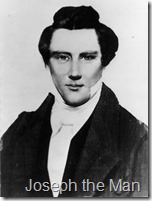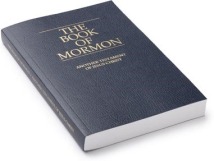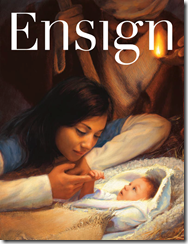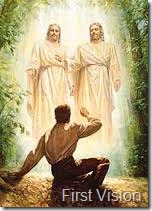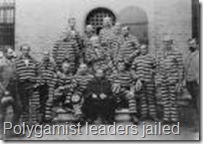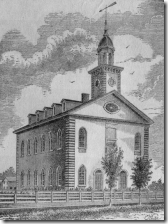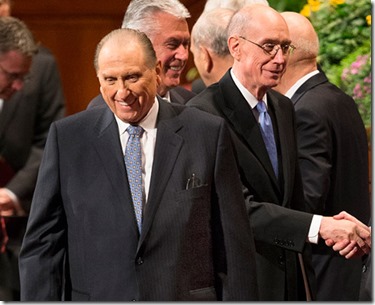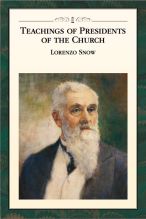Mormon Colours Firmly Nailed Down?
I begin by commending those who have gone before me in reporting and commenting on these conference sessions. The standard and quality of research and writing improves every time. This project is fast becoming a tradition and work whose coming around I anticipate with enthusiasm. We are used to the idea that someone with a Mormon background, such as myself, has an advantage in understanding and insight. Former Mormons have blind spots too, and these posts prove that an advantage is had by those who have never been Mormons, who bring fresh eyes, new perspectives and insights.
As I have read through the essays a theme has emerged for me, one that has coloured this last, Sunday afternoon, session every bit as much as it has coloured the whole conference.
The Mormon Church has figured much in the issue of gay rights in recent years. It began negatively when it emerged that as much as half the $40m donated to the campaign to ban gay marriage in California came from Mormons. At that time the church made an unequivocal statement saying “the formation of families is central to the Creator’s plan,” and urging members to become involved with the cause. You can read about it here.
More recently, however, the Mormon Church has expended a lot of time, energy, and resources into building bridges to the gay community, even having their own official, dedicated web pages Mormons and Gays.org. Mormon leaders pledged to support anti-discrimination laws for gays, lesbians, bisexuals and transgender people, as long as the laws also protect the rights of religious groups. You can find a report here.
The church has not changed its position on gay marriage, however. On 10th April 2015 the LDS Church joined with other faith traditions and religious organizations in asking the U.S. Supreme Court to rule against legalized same-sex marriage nationwide. Read more here.
Families Are Still Forever
This Spring Conference weekend has seemed to me a time of regrouping, consolidating, and nailing colours well and truly to the mast, lest the faithful felt the church leadership had gone soft on its central message; families are forever, marriage is for eternity, progeny its purpose, and men and women its natural heads. To illustrate:
The General Women’s Session is summed up by Lucy Marskell, who observed, ‘If I had to summarise the main message behind this year’s Women’s session it would be, ‘Keeping families together is the solution to persevering under persecution’.’
Her appraisal of the message is soundly biblical and thought-provoking and the way Lucy handles the Mormon Testimony issue deserves attention. But the message is families, and Lucy has some valuable insights to offer.
The Saturday Morning Session review by Jamie Lundy is rich with insights. Jamie observes, ‘As the Saturday morning conference session “strolled along” I began to notice a certain theme developing in the lectures…Many of the lectures centred on the family structure within Mormon practice and theology.’
The Saturday Afternoon Session is covered by Jim Gourlay, who handles one of my favourite subjects, church statistics, with great competence and I will spend some time over it in the days to come. But the quote that catches my eye comes from the same speaker, Elder Quentin L Cook whose talk gave strong emphasis to families:
‘The role of the family in God’s plan is “to bring us happiness, to help us learn correct principles in a loving atmosphere, and to prepare us for eternal life.” The beautiful traditions of religious observance in the home need to be embedded in the hearts of our children.’
The General Priesthood Session is covered by Pastor Tony Brown and if you want a Christian insight into Mormon priesthood you couldn’t do better than read Tony’s commentary. He sums up the Fatherhood section with both humour and sharp insight:
‘As young men listen to the message, they know it is their duty to go on a mission, then find a wife, then have a plethora of children; after all there are many ‘spirit’ children needing to come and work out their plan of salvation. They then need to be a good father and to lead their children to become faithful Latter Day Saints. Welcome to the Priesthood boys!’
The Sunday Morning Session got Bobby’s attention and he covered a very deceptive and tricky talk by the man who is increasingly the acceptable face of Mormonism, Dieter Uchtdorf. This is a must read if you are to understand Mormonism’s Dog-Whistle Theology But again family loomed large this session in Elder Brent Nielson’s talk about the prodigal.
And so to my own assignment:
The Sunday Afternoon Session
This begins with what, on the face of it, is a call to use our freedoms wisely, and to honour religious freedoms. Elder Robert D Hales’ talk is entitled Preserving Agency, Protecting Religious Freedom. This is clearly a timely reference to the recent attempts at a quid pro quo with the gay community. We will fight for your freedoms but you must recognise ours. The key to the talk is the word, ‘Agency.’
To a Mormon, agency is a touchstone of their religion, a defining principle of their faith, a shibboleth to the faithful. Hales’ talk is an unpacking of Mormon cosmology against a very specific background. He defines the bad guys:
Some are “false accusers … [and] despisers of those that are good.” Others “call evil good, and good evil; [and] put darkness for light, and light for darkness.”
These are likened to Lucifer who, ‘In that Grand Council…used his agency to oppose God’s plan. God said: “Because … Satan rebelled against me, and sought to destroy the agency of man, which I, the Lord God, had given him, … I caused that he should be cast down.”’
So that is ‘pre-mortal existence’ affirmed, with all its ramifications. We are all children of a Heavenly Father and Mother, Jesus is our elder brother, Lucifer the black sheep of the family, and our purpose is to build for eternity now on the wise use of our agency back then. All this passes through the mind of a Mormon hearing this. The bad guys are those who oppose this family-oriented world-view, this cosmological soap opera.
He presses home his point by defining the good guys and what they are up against:
‘As we walk the path of spiritual liberty in these last days, we must understand that the faithful use of our agency depends upon our having religious freedom. We already know that Satan does not want this freedom to be ours. He attempted to destroy moral agency in heaven, and now on earth he is fiercely undermining, opposing, and spreading confusion about religious freedom—what it is and why it is essential to our spiritual life and our very salvation.’
Jesus, on the other hand, is portrayed as volunteering to obey God’s plan and give mankind our agency to choose, to follow the plan, to obey the commandments. This principle of agency is inevitably meant to chime with people who cherish the freedoms that democracy affords.
The message is, America is a democracy, democracy is God’s idea, religious freedom is God’s idea, so don’t mess with it. To Mormons specifically, the message is, American exceptionalism is part of the Restored gospel, with all its attendant liberties, egalitarianism, and individualism so if you are faithful you will stick to the plan.
What is at stake here, then, is not simply a redefining of societal norms, but the undermining of God’s plan, and the frustration of eternal hopes and ambitions. He ends with a dire warning and a call to action:
‘Our Savior’s Second Coming is drawing nearer. Let us not delay in this great cause. Remember Captain Moroni, who hoisted the title of liberty inscribed with the words “In memory of our God, our religion, and freedom, and our peace, our wives, and our children.” Let us remember the people’s response: exercising their agency, they “came running together” with a covenant to act.
My beloved brothers and sisters, don’t walk! Run! Run to receive the blessings of agency by following the Holy Ghost and exercising the freedoms God has given us to do His will.’
Anyone who knows the Book of Mormon (and after his recent reading feat Bobby should) will know the story of Captain Moroni. It is the words on the banner that are important;“In memory of our God, our religion, and freedom, and our peace, our wives, and our children.”
Nothing could sound more Tea Party America. Did someone just say, ‘Families are Forever?’
Faithfulness
The theme of faithfulness then follows throughout the session. Elder Kevin Pearson urges members to ‘stay by the tree,’ a reference to Lehi’s dream in the Book of Mormon. The tree is contrasted with the dream’s ‘wide and spacious building,’ the forces of anarchy and change currently surrounding Mormons and threatening the plan.
Elder Raphael E Pino urges members to take an ‘eternal perspective of the gospel’ In other words, the metanarrative of Mormonism, the Plan of Salvation, God’s great plan of happiness for mankind.
Elder Neil L Anderson paints a deceptive picture of the size of the church as a world-wide institution. It is only world-wide in the sense that there are Mormons across the world, but not in the sense that they form a significant majority of the faithful. Most Mormons live in the Americas, the greater part of them in the US. But this is meant to be reassuring. I am reminded that one of the most foolish things a popular public figure can do is believe their own publicity.
He urges Mormons to remember ‘We live, brothers and sisters, in the days preceding the Lord’s Second Coming, a time long anticipated by believers through the ages.’ Thy Kingdom Come is his theme and when Mormons think of this they think of eternal families and what would be lost if they weren’t faithfully having babies, going to the temple, and being eternal family units.
Referencing again the tree of life, Elder Jorge Zeballos urges members to be responsible, the theme of agency coming to the fore again, ‘Let us press forward by learning our duty, making correct decisions, acting according to those decisions, and accepting the will of our Father.’ His will, of course, his purpose, is worked out in the plan.
Elder Russell M Nelson is the final speaker and says the Sabbath is a delight. The theme very much runs along the line of families, family times, family activities on the Sabbath, and so the theme continues.
But before he spoke there was a penultimate message from the first black African General Authority, Elder Joseph W Sitati. His culture and background are not insignificant I suggest. His theme is very much a closing off of the whole conference theme as he reminds True Believing Mormons that procreation is the name of the game, the centre-point of God’s plan. Be fruitful, multiply, and subdue the earth is his theme, and he makes probably the most pointed observation of the whole weekend:
‘The body enables Heavenly Father’s obedient spirit children to experience life on earth. Bearing children gives other spirit children of God the opportunity to also enjoy life on earth. All who are born in mortality have the opportunity to progress and to be exalted if they obey God’s commandments.
Marriage between a man and a woman is the institution that God ordained for the fulfilment of the charge to multiply. A same-gender relationship does not multiply.’ (Emphasis added)
What Robert D Hales began with, premortal existence, agency, and the plan of God, Joseph W Sitati rounds off with a clear call to stick to the plan, have babies the way God designed, and make this arrangement eternal by sealing it in temples.
We may agree with Mormon teaching on gay marriage, sympathise with their being the focus of so much bad feeling because of their stand, and admire the way they stick to their guns, but…What colours should be flying from the mast for Christians? What should be written on any Christian’s standard as he/she stands for truth?
The Bible
It is notable that there is no reference to the clear teaching of Scripture on the issue of homosexual practice, even though the Bible is clear. There is nothing in the Book of Mormon, the Doctrine and Covenants, or the Pearl of Great Price on the subject. The only Scripture they can look to on this issue is the Bible and yet no real Scriptural argument, no Bible apologetic is put.
Nor, indeed, can they build from the Bible anything like the Mormon cosmology, soteriology, or eschatology. Their argument revolves around God’s plan of happiness for man and not God’s authoritative word in Scripture. They are making a stand for a gospel that puts man and man’s happiness at the centre, that seeks man’s exaltation. (Gal.1:6-9)
The Plan
There is a plan and God’s purposes are clearly told in the Bible:
“The God who made the world and everything in it, (we are created and not procreated Gen.1:27; Is.45:12) being Lord of heaven and earth, (there is none beside him Is.45:5) does not live in temples made by man, (heaven is his throne and the earth is his footstool Is.66:1) nor is he served by human hands, as though he needed anything, since he himself gives to all mankind life and breath and everything.
And he made from one man every nation of mankind (not from one god countless millions of spirit children) to live on all the face of the earth, having determined allotted periods and the boundaries of their dwelling place, that they should seek God, in the hope that they might feel their way toward him and find him. (Our purpose is God, not us his purpose)
Yet he is actually not far from each one of us, “‘In him we live and move and have our being’; as even some of your own poets have said, “‘For we are indeed his offspring.’ (In the sense of being made in God’s image Gen.1:28, being chosen for his purposes Ex.4:22, and finally being born again in Christ Gal.3:26)
Being then God’s offspring, we ought not to think that the divine being is like gold or silver or stone, an image formed by the art and imagination of man. (As God’s creatures, made in his image, we are to honour him, not in plastic image worship but in the God-centred lives he gave us)
The times of ignorance God overlooked, (We are profoundly sinful in our ignorance Ro.3:10-18, but God is scandalously generous, not exactingly demanding of us) but now he commands all people everywhere to repent, (patiently giving us the gift of repentance 2 Pet.3:9) because he has fixed a day on which he will judge the world (his creation) in righteousness (we have none of our own Philip.3:9) by a man whom he has appointed; and of this he has given assurance to all by raising him from the dead.” (And it is in him, in Christ, that we have peace with God Ro.5:1, and will not be condemned Ro.8:1-2; John 5:24)
Acts 17:24-31
Thereafter, as the Larger Westminster Catechism has it; Man’s highest end is to glorify God, and fully to enjoy him for ever.
Here is what should emblazon the standard of every Christian:
‘For from him and through him and to him are all things. To him be the glory forever. Amen.’ (Ro.11:36)
Mike Thomas was a Mormon for 14 years, became a Christian in 1986 and is the chairman of Reachout Trust, a ministry to the cults. He writes The Mormon Chapbook blog, curates and writes for the Reachout blog, Bridge of Reason, and for the Reachout monthly e-newsletter. Mike is a public speaker, preacher, and elder in a local Baptist church.




